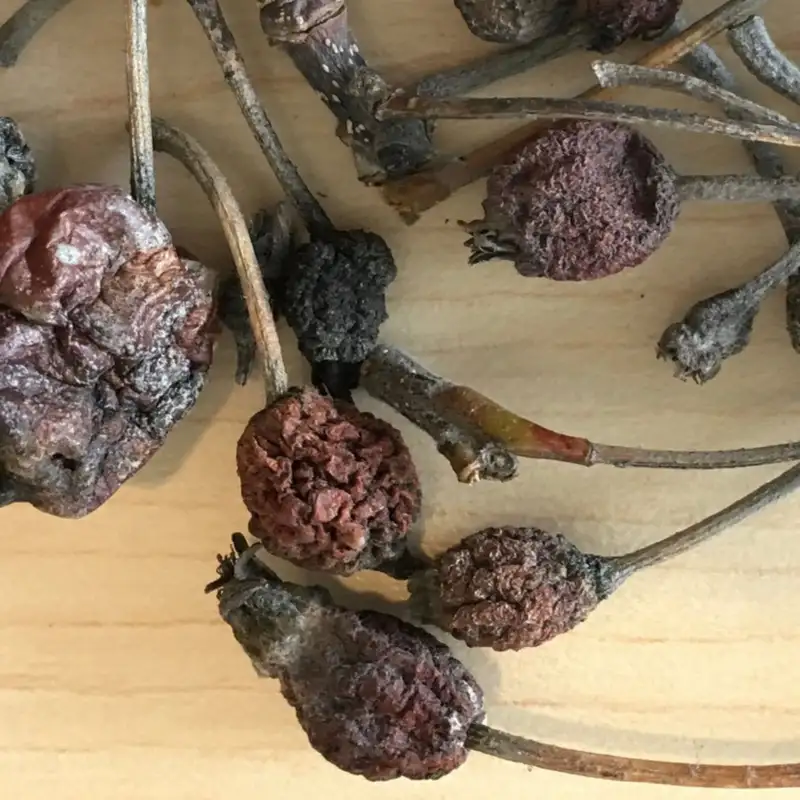Fruit Mummies with Kerik Cox
Download MP3Have you ever found mummified and immature fruit on your fruit trees? Learn what's happening and how to prevent this using botanical sprays in this episode of the Orchard People podcast.
Our guest is Plant Pathologist, Mycologist, and Bacteriologist Kerik D. Cox Ph.D. of the Cox Program at Cornell University.
The host of the Orchard People radio show and podcast is Susan Poizner of the fruit tree care education website www.orchardpeople.com.
This show goes out LIVE on the last Tuesday of every month at 1.00 pm Eastern Time. After that you can download the podcast.
To tune in LIVE (and submit your questions to our expert guests!) you can:
- Tune into RealityRadio101.com during the time of the live show
- OR watch the livestream on the Orchard People YouTube Channel
Do you want to learn to grow organic fruit trees successfully? Sign up for OrchardPeople.com's free monthly newsletter at https://orchardpeople.com/sign-up/
For premium fruit tree care education visit: https://learn.orchardpeople.com/.
About Cinnerate Fungicide: https://sym-agro.com/our-products/cinnerate-miticide-fungicide/
Chapters:
Want to make your own botanical fruit tree spray? Here’s a recipe to try. While this spray is all-natural, it can harm beneficial insects like bees, so be sure to spray at a time when bees aren’t active (early morning and late evening). Keep an eye out for bird nests and avoid spraying near them. And remember, you wouldn’t want to get this in your eyes or on your skin, so handle it with care!
- (00:00) - Fruit Mummies in an Historic Orchard
- (00:35) - What are Mummy Fruits
- (01:18) - Guest Introduction: Kerik Cox
- (01:52) - What Cornell's Cox Labs Does
- (03:12) - Causes of Undersized Fruitlets
- (04:26) - Should You Worry about Mummy Fruits?
- (09:53) - A Good Book about Growing Apples and Pears
- (10:36) - Mummy Fruits on Apricot Trees and Environmental Stress
- (14:57) - Can Fruit Mummies be Bacterial?
- (15:59) - Fire Blight and Its Impact on Fruitlets
- (17:14) - How to Prevent Fruit Mummies
- (18:33) - Why Oxygen is the Best Fungicide (and Bacteriacide)
- (19:12) - Why Does Correct Fruit Tree Pruning Deter Pathogens?
- (21:38) - What is Fire Blight
- (23:33) - UV Light Treatment to Prevent Fruit Tree Diseases
- (26:41) - Protectiing Fruit Trees from Disease with Sanitation
- (27:44) - Arborist Mulch and DIsease
- (29:34) - Sponsor Messages and Announcements
- (31:08) - Fruit Tree Care Tips and Advice
- (33:07) - Discussion on Fruit Mummies and Disease Control
- (34:03) - Covering Fallen Fruit Mummies and Leaf Litter with Mulch or Using Urea
- (38:00) - Recommended Mulches for Smothering Pathogens
- (40:19) - Should You Put Fruit Mummies in Your Compost?
- (41:09) - Managing Peach Leaf Curl
- (44:15) - Botanical Products for Disease Control
- (51:21) - Can Botanical Sprays Harm Beneficial Insects and Wildlife
- (54:15) - Integrated Pest Management and Spraying Tips
- (57:23) - Conclusion and Upcoming Episodes
Want to make your own botanical fruit tree spray? Here’s a recipe to try. While this spray is all-natural, it can harm beneficial insects like bees, so be sure to spray at a time when bees aren’t active (early morning and late evening). Keep an eye out for bird nests and avoid spraying near them. And remember, you wouldn’t want to get this in your eyes or on your skin, so handle it with care!
Garlic Fruit Tree Spray
Garlic is known for its strong scent, which can deter many types of pests, from aphids to caterpillars and even some types of fungi.
Ingredients:
- 1 pound of garlic
- 1 gallon of water (rainwater is best)
Instructions:
- Peel and Mince: Start by peeling the garlic cloves. Then, mince or finely chop them to release the essential oils. The finer, the better.
- Simmer: Combine the minced garlic with water in a large pot. Bring the mixture to a simmer (not a full boil) and let it cook for about 20 minutes. This process infuses the water with garlic's active compounds.
- Cool and Strain: After simmering, take the pot off the heat and let it cool. Once it's cool, strain the mixture to remove the garlic pieces. A cheesecloth or a fine mesh strainer works great for this. You want the liquid as clear as possible to prevent any sprayer clogs.
- Dilute (Optional): Depending on what you're dealing with, you might want to dilute the mixture. A common approach is to dilute the concentrated garlic water with more water. This step is adjustable based on your needs and the sensitivity of your plants.
- Bottle Up: Pour the strained, cooled liquid into a spray bottle or a larger sprayer for application. It’s ready to use!
- Apply: Spray it on the leaves of your fruit trees, covering both the tops and undersides where pests like to hide. Early morning or late afternoon is the best time to apply, avoiding the hot midday sun to reduce the risk of burning the leaves.
Tips:
- Storage: You can store the garlic spray in the refrigerator for up to a week. For longer storage, freeze it in an ice cube tray and thaw cubes as needed.
- Test: Always test the spray on a small area of the plant first to ensure it doesn't react badly.
- Reapply: After rain or watering, you might need to reapply, as it can wash off.
Creators and Guests

Host
Susan Poizner
Author, fruit tree educator, and Creator of the award-winning fruit tree care education website OrchardPeople.com.

